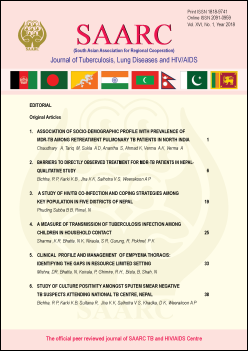A Measure of Transmission of Tuberculosis Infection among Children in Household Contact
DOI:
https://doi.org/10.3126/saarctb.v16i1.23241Keywords:
Tuberculosis, Contact Tracing, Under Five ChildrenAbstract
Introduction: Tuberculosis (TB) is transmitted through droplets from patients having pulmonary TB, Young children living in the same household are at higher risk Tuberculosis, with great potential to benefit from screening and preventive treatment. This study was conducted with the objectives to estimate the prevalence of TB infection among under five years old children in household contact with pulmonary tuberculosis patients, and assess the factors associated with transmission of TB.
Methods: Pulmonary TB patients receiving treatment from the DOTS Centres in Sunsari District (Index Case-IC) were visited in their household to identify and assess contacts below five years of age. Transverse induration greater than10 mm was defined as a positive Mantoux test suggestive of tubercular infection.
Results: Among 190 household contacts, Mantoux was positive in 13.7% (95%CI: 11.2-16.2). Higher sputum bacillary load (adjusted OR=3.03; 95% CI 1.01-9.1) and spitting habits of Index Cases (aOR=3.1; 95% CI 1.2-7.7), first-degree relationship (aOR=3.5; 95%CI 1.4-8.7) and longer duration of contact (aOR- 6.7; 95% CI 1.4-32.2), were factors significantly associated with positive Mantoux test in the under-five years old household contact.
Conclusion: The prevalence of tuberculosis infection among under-five children in contact with pulmonary tuberculosis patients was 13.7%, which is nearly double than the results of first national tuberculin survey (7%), conducted by National Tuberculosis Centre. This highlights the need for a competent & functioning contact tracing mechanism to halt the chain of transmission of infection. Social and behavioral factors existing in the household were significantly associated with the transmission of Tuberculosis infection.
Downloads
Downloads
Published
How to Cite
Issue
Section
License
Copyright © SAARC Tuberculosis and HIV/AIDS Centre (STAC), all rights reserved, no part of this publication may be reproduced, stored in a retrieval system or transmitted in any form or by any means without prior permission of the STAC.





